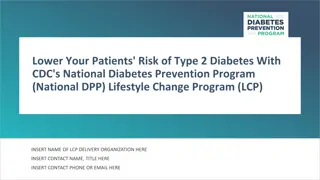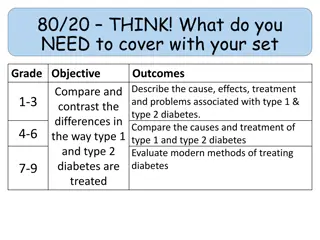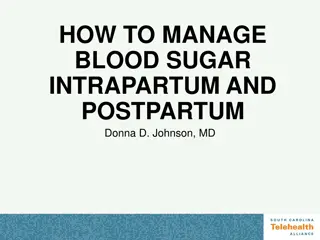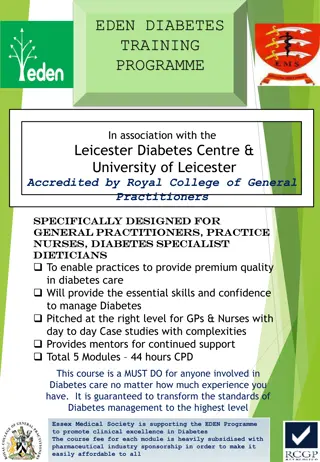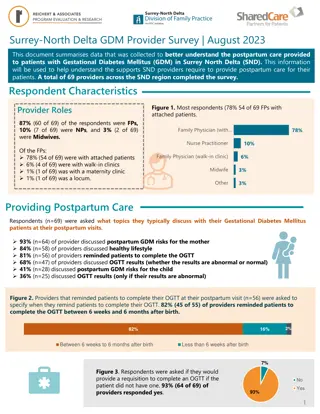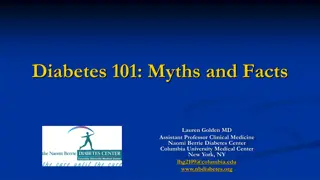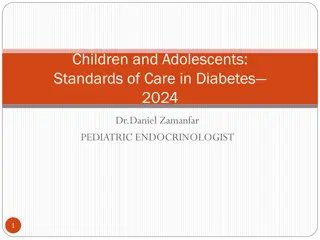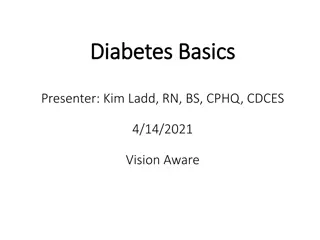Management of Type 1 Diabetes in Women: Preconception to Postpartum
Women with Type 1 Diabetes can have healthy pregnancies with optimal glycemic control and multidisciplinary care. Preconception counseling is crucial to reduce risks and ensure optimal outcomes for mother and baby. This article discusses the importance of managing diabetes from preconception through postpartum, including the risks associated with uncontrolled hyperglycemia during pregnancy, insulin sensitivity changes, and the need for frequent insulin adjustments. The materials and methods used in researching this topic are also detailed.
Download Presentation

Please find below an Image/Link to download the presentation.
The content on the website is provided AS IS for your information and personal use only. It may not be sold, licensed, or shared on other websites without obtaining consent from the author.If you encounter any issues during the download, it is possible that the publisher has removed the file from their server.
You are allowed to download the files provided on this website for personal or commercial use, subject to the condition that they are used lawfully. All files are the property of their respective owners.
The content on the website is provided AS IS for your information and personal use only. It may not be sold, licensed, or shared on other websites without obtaining consent from the author.
E N D
Presentation Transcript
Type 1 Diabetes: Management in Women From Preconception to Postpartum The Journal of Clinical Endocrinology & Metabolism 16 January 2021
women with type 1 diabetes mellitus (T1DM) can have healthy, safe pregnancies with optimal glycemic control and multidisciplinary care. The prevalence of T1DM in pregnancy is increasing worldwide . Given the risks of hyperglycemia during pregnancy, preconception counseling should begin in early puberty and continue throughout the reproductive years for women with T1DM . Glucoses should be maintained as normal or near normal with minimization of hypoglycemia during conception and pregnancy for optimal gestational outcomes for mother and neonate.
Uncontrolled hyperglycemia increases the risk of fetal loss (spontaneous abortion or stillbirth), congenital anomalies, pre-eclampsia, and macrosomia. With effective preconception planning, glycemic control, and control of risk factors, the risk of adverse maternal and fetal outcomes can be reduced. Insulin sensitivity changes throughout gestation, and women need frequent insulin adjustments as directed by their diabetes care team. Insulin requirements decrease drastically postpartum, especially for breastfeeding mothers.
Materials and Methods: We conducted a search of the PubMed database from the past 50 years written in the English language using the search terms type 1 diabetes and pregnancy and management. The search resulted in 682 articles with more recent and relevant manuscripts preferred. The search included randomized controlled trials, observational studies, meta analyses, and guidelines from professional societies yielding 169 documents in total reviewed here.
Preconception : Overview and general counseling: The prevalence of T1DM among women of reproductive age is increasing globally . T1DM increases the risk of suboptimal maternal and neonatal outcomes including spontaneous abortion, congenital malformation, macrosomia, preterm delivery, perinatal mortality and morbidity , and potential future offspring metabolic abnormalities. All women of reproductive age with T1DM should be counseled on the effects of diabetes in pregnancy, of pregnancy on diabetes, and of pregnancy on complications of diabetes.
Preconception counseling should review glycemic goals at conception and during pregnancy, medical management to achieve glycemic targets, and optimization of care for existing diabetes complications or comorbid conditions. The American Diabetes Association (ADA) recommends that preconception counseling begin in early puberty and continue regularly in women of reproductive age with T1DM. For women not desiring pregnancy, providers should discuss acceptable methods for contraception and provide referrals if needed .
However, nearly 50% of all pregnancies with and without diabetes in the United States are unplanned which leads to a high risk of poor pregnancy outcomes among women with diabetes. Some risks could be reduced with prepregnancy planning and prevention. Severe maternal morbidity and death are related to high preconception and early pregnancy glycated hemoglobin A1c (HbA1c) . Similarly, infant mortality has been associated with poor maternal glycemic control during pregnancy.
Counseling on health risks: Diabetes providers should counsel women on risks of congenital anomaly with hyperglycemia during conception and early pregnancy. The most common congenital anomalies among women with diabetes include cardiac malformations, central nervous system (CNS) malformations, and urogenital malformations, in decreasing order . Women with T1DM have a 2- to 4-fold increased rate of congenital malformation , rates of 2.9% to 7.5% compared with women without diabetes . The risk increases with hyperglycemia at conception and during organogenesis (5-8 weeks after the last menstrual period)
With unplanned pregnancy, some women are unaware they are pregnant in early gestation, which can lead to uncontrolled hyperglycemia during organogenesis. The risks can be significantly reduced, but not eliminated, with optimal glycemic control before and during early pregnancy . Multiple studies have demonstrated that higher first trimester HbA1c increases risks of major congenital anomaly and miscarriage . Women with diabetes with an HbA1c 1% above the upper limit of the normal range increases the risk of congenital malformation with proportionally increasing risk as HbA1c rises (Table 1)
Historic data found a 20% to 25% risk of major congenital anomaly among women with T1DM with first trimester HbA1c >10% . In a study of ~2500 Swedish women with T1DM, the incidence of major cardiac defects was nearly 7-fold higher in women with HbA1c >9.1% and 2-fold higher in women with HbA1c <6.5% than in pregnant women without diabetes . Thus, even mild hyperglycemia or nonglycemic variables contribute to the increased risk of cardiac defect in this population. Only live births were included, so this study may have underestimated the incidence of more severe cardiac and other malformations.
In a review of 6225 women with T1DM, the prevalence of congenital anomaly was 6.4% with a 2-fold higher incidence of congenital malformations among women with T1DM with an early pregnancy HbA1c <7% than women without diabetes . The overall rate of congenital heart disease in women with pre-existing diabetes is 2% to 3% compared with a background rate of 0.4% to 0.9% . Some experts recommend universal screening of all pregnant women with pre-existing diabetes with a fetal echocardiogram in the second trimester while others recommend it only if an abnormality was seen on detailed ultrasound or in women with higher HbA1c.
A study of 378 pregnant women with pregestational diabetes at a large academic center found fetal echocardiogram to be most useful for women with an early pregnancy HbA1c >7.7% or abnormal detailed anatomy ultrasound, and would result in a cost savings of 63.3% per each additional minor congenital heart defect diagnosed . The overall prevalence of congenital heart disease was 4%. Finally, in women with T1DM, more common CNS malformations include neural tube defects (NTDs), sacral agenesis, microcephaly, and anencephaly. Folic acid supplementation started preconception can help reduce the risk of NTDs.
Because of the increased risks of congenital anomalies, a detailed fetal anatomy ultrasound should be done at 18 to 20 weeks of gestation . Screening for NTDs should be done with an ultrasound alone or in conjunction with a maternal serum alpha fetal protein. Interpretation of maternal serum alpha fetal protein values should be done cautiously in women with diabetes as the median level is lower than in women without diabetes.
Glycemic targets, coordination of care, and addressing medications : Goal glycemic targets before conception and during pregnancy with fasting and postprandial glucose targets are listed (Table 2). The goal HbA1c is <6.5% before conception and <6% during pregnancy, if possible with minimal hypoglycemia . For women with hypoglycemia unawareness or a history of severe hypoglycemia, these glycemic targets should be relaxed. Preconception, referrals for a team-based approach of nutrition counseling and diabetes education should be placed to ensure proper plans for nutrition and insulin management.
The provider and patient should review possible and appropriate initiation of glucose monitoring, including continuous glucose monitoring (CGM), and continuous subcutaneous insulin infusion (CSII) therapy (insulin pump) before and during pregnancy . Women should also be referred to maternal fetal medicine specialists for preconception counseling. All medications and supplements should be reviewed to determine safety of use during pregnancy. Some antihypertensive agents, such as angiotensin converting enzyme inhibitors and angiotensin receptor blockers, should be discontinued as they are associated with renal dysgenesis, calvarial hypoplasia, oligohydramnios, and fetal growth restriction .
Statins should be discontinued , although unlikely to be teratogenic . Women should start a daily prenatal vitamin containing folic acid ( 400 g) and potassium iodide (150 g) before trying to conceive and throughout pregnancy . Recommendations for folic acid supplementation vary among different professional groups with a minimum of 400 g recommended by the ADA and the American College of Obstetricians and Gynecologists (ACOG) , 800 to 1000 g daily for women with an increased risk of NTDs (ACOG) , and 5 mg daily preconception through the first trimester and 0.4 to 1 mg daily after 12 weeks of gestation through breastfeeding by the Endocrine Society . Similarly, the National Institute for Clinical Excellence , and the Society of Obstetricians and Gynaecologists of Canada recommend women with diabetes take 5 mg of folic acid in pregnancy.
Some studies have shown higher doses of folic acid (>400 g) reduce risk of NTDs among women with family history of NTD, and this could be extrapolated to consider higher dose supplementation among women with other risk factors for NTDs including diabetes . There have been some concerns that folic acid supplementation may mask the macrocytosis of vitamin B12 deficiency although this has not been supported in women under 50 years of age , and the 5 mg folic acid dose has been shown to be safe in pregnancy . Initial concerns regarding folic acid supplementation and increased incidence of twins have been disproven as has the association with asthma , allergy , or neoplasia . Some practitioners also recommend extra intake of docosahexaenoic acid (DHA), as there is evidence of reduced intake of DHA in pregnancy in US women and of reduced maternal fetal DHA transfer in women with diabetes .
Addressing comorbidities : Women with T1DM planning conception should be up-to-date on diabetes complications screening, includinga dilated retinal examination, urine protein-to- creatinine assessment, serum creatinine assessment, thyroid screening including thyroid-stimulating hormone and thyroid peroxidase antibody if not known, and HbA1c . Women aged 35 or older with signs, symptoms, or risk factors of macrovascular disease should have an electrocardiogram, and if abnormal an echocardiogram and lipid panel . Known coronary artery disease is a contraindication to pregnancy due to high risks of morbidity and mortality . Case reports of myocardial infarction during pregnancy among women with T1DM are rare .
All women with T1DM planning pregnancy should have a complete physical examination, including a comprehensive foot examination. Providers should formulate disease management plans for women with comorbid conditions and complications including hypertension, cardiac disease, nephropathy, retinopathy, thyroid disease, obesity, and Rh incompatibility. For overweight or obese women with T1DM, weight loss should occur prior to conception, for which a referral to a registered nutritionist is helpful. Obesity is a growing epidemic among adults, especially women, with T1DM , and obesity is an independent risk factor for congenital anomalies, including NTDs and cardiac defects .
Obesity is also an independent risk for poor maternal pregnancy outcomes , including operative delivery, postpartum hemorrhage, and wound infection. Obesity is commonly associated with other comorbidities including hypertension, hyperlipidemia, and obstructive sleep apnea (OSA) . OSA worsens insulin resistance and glycemia among pregnant women with obesity and can contribute to poor pregnancy outcomes . Therefore, women with diabetes who are obese should be screened for OSA prior to pregnancy if possible, and, if diagnosed, treated with continuous positive airway pressure.
Pregnancy : Glucose goals and monitoring: During pregnancy, women with T1DM should work closely with their diabetes care team to achieve optimal glycemic control for maternal and fetal health. Glucose should be checked fasting, before meals, and 1 or 2 hours after the start of meals. Current guidelines by several professional organizations (ADA, ACOG, Endocrine Society, National Institute for Clinical Excellence, and Australian Diabetes in Pregnancy Society) recommend monitoring either the 1 or 2 hour postprandial glucose level. There are few studies evaluating the timing of the postprandial glucose excursion in women with T1DM.
In the Diabetes in Early Pregnancy study, the 1 hour postprandial glucose was more closely associated with fetal abdominal circumference and macrosomia in 323 women with T1DM . In women without diabetes, the peak glucose rise is at 1 hour postprandial, and in women with gestational diabetes, the Hyperglycemia and Adverse Pregnancy Outcomes study showed that the 1 hour postprandial glucose was associated more strongly than the 2 hour postprandial glucose value with perinatal outcomes including birth weight >90th percentile, percent body fat, sum of skin folds, neonatal hypoglycemia, and primary cesarean section . Several other studies of women with gestational diabetes show that the 1 hour value may be more sensitive at detecting hyperglycemia than the 2 hour postprandial glucose.
Women at risk of hypoglycemia or with symptoms of hypoglycemia or hyperglycemia should be encouraged to check glucose levels more often, especially overnight. Hypoglycemia unawareness can be more common in pregnancy. Women with T1DM and their partners should be trained on hypoglycemia recognition, management with and without glucagon administration, and prescribed glucagon emergency kits. Women should be encouraged to wear medical alert identification. Although there are targets for HbA1c, it is not as accurate in pregnancy due to a physiologic lowering (~0.5%) from increased red blood cell turnover and plasma volume .
Furthermore, while HbA1c is an average measure of glucose control, it does not reflect glucose variability or episodes of severe or frequent hypoglycemia. The ADA and ACOG recognize some benefits of adjunctive CGM use in pregnancy . It is not recommended to use CGM alone in pregnancy, but rather as adjunctive therapy with self-monitored blood glucose (SMBG) values. In pregnancy, the mean sensor glucose may be better at estimating glycemic control than HbA1c. The International Consensus on Time in Range recommends increasing time in range in pregnancy quickly and safely with a goal sensor glucose range of 63 to 140 mg/ dL (3.5- 7.8 mmol/L) with >70% time in range, <25% time above range (>140 mg/dL (>7.8 mol/L), <4% of time below 63 mg/dL (<3.5 mmol/L), and <1% time below 54 mg/dL (<3 mmol/L) .
Diabetes complications : Women with T1DM during pregnancy should be up to date on diabetes complications screening. If not performed preconception, a dilated retinal examination should be done in early pregnancy. Retinopathy can progress rapidly during pregnancy. An estimated 34% to 72% of women with T1DM have retinopathy in early pregnancy . Known retinopathy before pregnancy, especially proliferative or moderate to severe nonproliferative retinopathy, longer diabetes duration, and higher blood pressure during pregnancy have been associated with retinopathy progression during pregnancy . Higher HbA1c with rapid improvement in gestation, especially before 14 weeks of gestation, is a risk factor for gestational progression of retinopathy, especially in women with baseline moderate to-severe retinopathy .
Typically, advanced treatments for retinopathy are avoided in pregnancy, but some women with progression or vision loss may require laser photocoagulation therapy. Although rare, there are case reports of intravitreal antivascular endothelial growth factor injections in early pregnancy . There are few studies on neuropathy in pregnancy, including autonomic neuropathy such as gastroparesis. Autonomic neuropathy increases the risk of other gestational complications including hyperemesis gravidarum, hypoglycemia unawareness, and orthostatic hypotension.
Gastroparesis is very challenging to manage during pregnancy, especially when severe, and can lead to hypo- or hyperglycemia, diabetic ketoacidosis (DKA), dehydration, and malnutrition. Careful nutrition assessment, insulin management, and hydration are necessary. Severe gastroparesis during pregnancy may require inpatient care and total parenteral nutrition . Antiemetics and prokinetic medications (such as metoclopramide) approved for use in pregnancy can be used if needed
For women with gastroparesis on insulin pump therapy, specific extended bolus settings (such as the square wave bolus) may better control postprandial glucose levels, though this is off-label. For women not on insulin pumps, this type of dual bolus set up may be created by administering 2 small boluses for the meal at 60- to 120-minute intervals for better postprandial glycemic control. For women with chronic hypertension (diagnosed prepregnancy or <20 weeks of gestation), antihypertensive agents approved for use in pregnancy include labetalol, nifedipine, methyldopa, diltiazem, clonidine, and prazosin . Per ADA guidelines, antihypertensives should be initiated if systolic blood pressure is consistently >135 mmHg or diastolic >85 mmHg in pregnant women with diabetes and hypertension or proteinuria.
Target blood pressure on treatment should be above 120/80 mmHg due to potential risk of fetal growth restriction with lower targets , although there is significant controversy over the blood pressure targets for pregnant women. ACOG recommends antihypertensive therapy for women with blood pressures 160/105 without end organ damage, but for women with diabetes and evidence of nephropathy or other end organ damage they recommend a blood pressure target of <140/90 mmHg to limit worsening nephropathy during pregnancy . pregnant women with T1DM and nephropathy have increased risk of poor maternal and fetal outcomes. These risks are worse in women with progressively lower glomerular filtration rate, chronic hypertension, or proteinuria .
Maternal adverse outcomes include progression of proteinuria and worsening renal function, development of gestational hypertension, pre-eclampsia, HELLP (hemolysis, elevated liver enzymes, and low platelets) syndrome, and miscarriage, while fetal adverse outcomes include preterm birth, stillbirth or neonatal death, and intrauterine growth restriction. Some studies show increased risk of pre-eclampsia with suboptimal glycemic control, but others have not . Twenty-four hour urine protein and creatinine should be measured in the first trimester, and repeated later in pregnancy if gestational hypertension or other signs of pre-eclampsia develop.
pre-eclampsia: Pregnant women with T1DM have a 4 to 6 times increased risk of pre-eclampsia than women without diabetes . A systematic review of >11 000 women with T1DM found a 17% prevalence of pre- eclampsia, with increasing incidence among women with chronic hypertension (odds ratio [OR] 3.8-17.1), nephropathy (OR 3.7-23.5), microalbuminuria (OR 3.8-11.7), and diabetic retinopathy (OR 1.9-2.9) . Poor glycemic control , nulliparity , and obesity are risk factors for pre-eclampsia among women with T1DM. One study found that women with good glycemic control preconception and in the first trimester had a lower incidence of pre-eclampsia than women with higher HbA1c at those times , but this has not been confirmed with other larger studies .
In a study of women with pregestational diabetes, early HbA1c at the first prenatal visit was significantly associated with pre-eclampsia: HbA1c 7.7% on average in the women who developed pre-eclampsia compared with 6.7% in those without pre-eclampsia (P = .0001) with similar HbA1c values at delivery . In this same study, antiangiogenic factors including soluble fms-like tyrosine kinase 1 and placental growth factor were significantly higher in women with diabetes who developed pre-eclampsia than in those who did not develop pre-eclampsia . While higher HbA1c has been associated with increased risk of pre-eclampsia, this is not consistent across all studies.
The presence of microangiopathies (such as retinopathy and microalbuminuria) may predict pre-eclampsia in women with T1D, suggesting that the impaired placental development of pre-eclampsia is associated with systemic vasculopathies . the United States Preventative Task Force recommends aspirin beginning at 12 weeks of gestation for women with increased risk of pre-eclampsia, including women with T1DM . Aspirin therapy should begin between 12 and 16 weeks of gestation, definitely before 28 weeks, and continued until delivery. Women with nephropathy, chronic hypertension, and prior pre-eclampsia are at heightened risk. Aspirin dose recommendations range from 60 to 150 mg daily, typically provided as 81 mg daily.
weight gain : Pregnant women with T1DM should be counseled to adhere to gestational weight gain guidelines from the Institute of Medicine based on body mass index (Table 3).
Changes in insulin requirements: Insulin requirements change dramatically during pregnancy. Insulin resistance and therefore insulin requirements rise in the second and third trimesters . However, insulin requirements change in early pregnancy as well with a characteristic decrease in insulin requirements between 7 weeks of gestation and 15 weeks of gestation . Some studies have identified an 18% rise in insulin requirements in early pregnancy (between 3 and 7 weeks of gestation) in the Diabetes in Early Pregnancy Study (n = 281 subjects) or before 9 weeks of gestation in Garc a-Patterson s data (n = 65 subjects) After this initial rise in insulin requirements in early pregnancy, clinicians should expect and counsel patients on the decrease in insulin requirements between 6/7 and 12 weeks of gestation which can predispose pregnant women to hypoglycemia in early pregnancy.
It has been shown that glucose levels also decrease in women without diabetes in early pregnancy . In women with T1DM, a nadir of insulin dosages occurs at week 16 near prepregnancy insulin doses, and an increase in insulin resistance and resulting insulin requirements is seen from weeks 16 through 35 . There is an estimated 5.19% increase in insulin requirements per week after the first trimester compared with prepregnancy insulin doses . A plateau or continual slight increase in requirements occurs between weeks 35 through delivery, although some women especially with longer durations of T1DM may have decreases in insulin requirements at this time.
Insulin requirements are affected by prepregnancy weight, gestational weight gain, carbohydrate intake, and activity levels. Most women with T1DM require 1.5 to 2 times the prepregnancy insulin requirement the third trimester . Insulin requirements during pregnancy can be increased in certain settings including multiparity , a multiple pregnancy , and recent diabetes onset , although this is conflicting. Alternatively, gestational insulin requirements may be reduced for some women with T1DM who have longer diabetes duration, suggesting possible placental insufficiency , and with renal or hepatic dysfunction. Women using CSII require slightly less total daily insulin than those on multiple daily injections (MDIs) (increase in total daily dose of insulin per kilogram of 40% CSII versus 52% MDI).
Medications: Insulin is the only recommended pharmacologic treatment for T1DM during pregnancy. Multiple long- and short-acting insulins are safe to use in pregnancy. Available human insulins generally do not cross the placenta, unless bound to an antibody . It is recommended to use insulins which have been shown to have a strong safety profile for use in pregnancy.For basal insulins, detemir and neutral protamine hagedorn (NPH), are preferred given safety data. Glargine insulin, a long-acting or basal insulin, has been shown to have higher affinity binding to the insulin like growth factor-1 receptor which is involved in embryo implantation into the uterus, which could contribute to detrimental effects in pregnancy such as miscarriage, fetal overgrowth, and congenital malformation .
However, many clinicians continue glargine use in pregnancy, especially in those women who have had difficult to control glucose levels on other insulins or given patient preference. A meta-analysis of more than 300 pregnant women with T1DM did not find any significant difference in maternal or neonatal adverse outcomes of glargine or determir use compared with NPH . A study of more than 300 pregnant women with T1DM found that detemir was noninferior to NPH for multiple maternal and neonatal outcomes . Degludec is a once daily ultralong-acting insulin analogue which may be safe to use in pregnancy although not preferred; there are several small case series of women (28 total) without adverse outcomes noted .
For shorter acting insulins, lispro or aspart are preferred over regular insulin given more rapid onset of action, which allows for better postprandial glycemic control . Glulisine and rapid- acting aspart have not been studied in pregnancy, although there are no reports of adverse outcomes . For women with T1DM with extreme insulin resistance (>200-300 units daily), regular concentrated insulin U-500 can be used with careful education. For T1DM, insulin is best provided via a basal and bolus insulin regimen. Basal insulin is administered by once or twice daily insulin injections or CSII. MDI therapy typically includes 4 to 7 injections per day. Timing of rapid acting insulin for carbohydrate coverage is very important: prebolusing at least 10 to 30 minutes before starting the meal (longer time in the third trimester) best achieves postprandial glycemic targets.
Bolus insulin doses should cover carbohydrate intake, best done with precise insulin to carbohydrate ratio calculations for women who can accurately count carbohydrates, and corrections for hyperglycemia. Referrals for diabetes education and nutrition counseling can help with necessary education. For women who are not familiar, interested, or able to count carbohydrates, set doses of prandial insulin can be provided to cover carbohydrate intake. Nutrition counseling should be available to women with T1DM during pregnancy. Food plans should be individualized based on a nutrition assessment and guidance from the Dietary Reference Intakes, which recommends all pregnant women consume a minimum of 175 g of carbohydrate, 71 g of protein, and 28 g of fiber daily in divided doses over each day .
Some women with T1DM may have followed a low-carbohydrate diet prior to pregnancy, and these women should be encouraged to increase carbohydrate intake with careful monitoring of fetal growth and maternal glucose levels. Simple carbohydrates should be avoided except for treatment of hypoglycemia due to rapid rise in glucose values, and complex carbohydrates are preferred. ACOG recommends that women consume an additional 300 calories per day in the second and third trimesters with 40% to 50% of calories coming from complex, fiber- rich carbohydrates, 15% to 30% from protein, and 20% to 35% from unsaturated fats.
Among women with T1DM, insulin requirements increase throughout pregnancy. Typically, women with T1DM require 0.7, 0.8, and 0.9 to 1 units/kg in the first, second, and third trimesters, respectively , although requirements are widely variable due to obesity, physical activity levels, and carbohydrate intake. If women are taking any noninsulin antihyperglycemic agents (GLP-1 agonists, SGLT-2 inhibitors) used off-label, these should be discontinued preconception or once pregnancy is identified. Biguanide therapy crosses the placenta, may lead to metabolic disease in the offspring, and is not a first-line agent in T1DM , therefore it too should be discontinued.
advanced diabetes technologies : Diabetes technologies including CSII and CGM can be beneficial to women before, during, and after pregnancy. CSII can deliver small increments of insulin, take into account insulin on board for multiple correction boluses, deliver precise bolus insulin delivery, and adjust basal rates hourly which can help with overnight glycemic control . Women using CSII prior to pregnancy can continue this therapy during pregnancy (off- label). Randomized controlled trials have not supported switching women from MDI therapy to CSII in pregnancy, though the studies were performed many years ago with older insulin pump models. Meta-analyses have not shown maternal or neonatal benefits of CSII over MDI therapy in pregnancy .
One study found more admissions for glucoregulation among women with T1DM using MDI rather than CSII . The ADA, ACOG, and Endocrine Society support use of insulin pumps during pregnancy, but CSII initiation should optimally be done prior to pregnancy so that patients can become familiar with CSII use preconception. Pregnant women using CSII need to be well trained in insulin pump or infusion site malfunction recognition and troubleshooting. Insulin pump settings are frequently adjusted as pregnancy progresses. The most aggressive changes are made in the overnight and early morning period to combat fasting hyperglycemia during the second and third trimesters . While basal and bolus insulin doses change throughout pregnancy, there is a disproportionate increase in bolus insulin requirements as pregnancy progresses.
CGM allows patients and providers to see glycemic trends throughout the day with multiple glucose values, including overnight and postprandially. CGM can also alert pregnant women with diabetes and their significant others of impending hypoglycemia, thus reducing or avoiding severe hypoglycemia. A 2019 systematic review of SMBG and CGM during pregnancy (n = 371 women with T1DM across 12 trials) with both T1DM and type 2 diabetes mellitus found a reduced incidence of gestational hypertensive disorders in women using CGM, but no statistically different association with pre-eclampsia.
Studies have not found significant maternal or neonatal benefit to intermittent CGM use in pregnancy , but have found benefits to continuous use. Near-constant CGM use in pregnancy has been associated with a decrease in neonatal hypoglycemia requiring intravenous dextrose and reduction of large-for-gestational age (LGA) infants . The Continuous Glucose Monitoring in Women with Type 1 Diabetes in Pregnancy Trial (CONCEPTT) was an international, multicenter, randomized controlled study assessing real-time CGM use in women with T1DM before and during pregnancy. There were 325 women before and during pregnancy randomized to real-time CGM use or SMBG .




